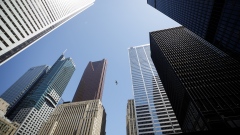Jun 27, 2024
Egypt’s $10 Billion Wind Farm Is Poised to Break Ground in 2026
, Bloomberg News
(Bloomberg) -- Construction of one of the world’s biggest wind farms in Egypt will begin by March 2026, a company involved said, as grueling power cuts during a broiling summer highlight the North African nation’s energy needs.
The onshore megaproject that will cost more than $10 billion will begin generating electricity in 2032, according to Mohamed Ismail Mansour, chairman of Infinity Power, a joint venture between Infinity in Egypt and Abu Dhabi-owned renewables giant Masdar.
Building of the 10-gigawatt project had been slated to begin this year, but was delayed due to the process of acquiring the land in the Upper Egyptian region of West Sohag, Mansour said in an interview.
Securing new sources of energy is a pressing issue for Egypt, which has been suffering about a year of scheduled power outages as soaring temperatures and other issues leave authorities struggling to meet electricity demand from its more than 105 million people.
While the country has significant offshore gas fields and has been a valued exporter to Europe, this year it’s being forced to again become an importer, with LNG purchases set to be the highest since 2018.
Authorities have allocated $1.2 billion for extra energy imports, including heavy fuel oil, in a bid to end the cuts this summer, Prime Minister Mostafa Madbouly said Tuesday.
The power due to be eventually generated by the Sohag farm would be a boon for Egypt, which has plans to decommission some of its gas-powered plants as renewable output grows. The country has an ambitious target of boosting the share of renewables in its energy mix to 42% by 2030.
Egypt is one of the few countries in Africa where the grid is expected to grow fast enough to absorb such new capacity, according to Mansour.
“Grids are a big challenge” for developers of larger electricity projects, he said.
Cameroon Entry
On the wider continent, Infinity Power is targeting by 2030 to increase its capacity to 10 gigawatts from 1.3 gigawatts. Part of that may happen in Cameroon, where it’s planning to raise $2 billion in debt and equity to develop smaller scale projects producing a combined 4 gigawatts.
Those projects, concentrated in Western Cameroon, may include solar, wind, battery storage and biomass facilities. The capacity of each will be relatively small — about 50 megawatts for solar, or 100 for wind — to avoid putting too much pressure on the grid, Mansour said.
African countries have been organizing themselves into regional pools that allow them to trade power among themselves. That’s enabling them to lure investments for trans-national markets, a situation that could benefit parts of central and western Africa that have some of the world’s lowest electrification rates yet the highest electricity costs in Sub-Saharan Africa.
Infinity Power is also looking to expand in South Africa after acquiring 60% of Amsterdam-based Lekela Power last year. The stake was worth about $1 billion, Bloomberg reported ahead of the sale. The company also bought a 40% stake from Mainstream Renewable Power Africa Holdings, becoming Lekela’s sole owner.
Infinity Power has five wind projects in South Africa and is keen to do more work there, although the country has been “a learning curve” because challenges at Eskom Holdings SOC Ltd forced the utility to withdraw available capacity, Mansour said.
To mitigate risks, the company is studying more than 10 projects in different regions, rather than focusing on a single area, he said.
Listen on Zero: How Wind Giant Vestas Turned Its Fortunes Around
--With assistance from Chris Miller.
(Updates with acquisition of remaining Lekela stake in third-last paragraph.)
©2024 Bloomberg L.P.







